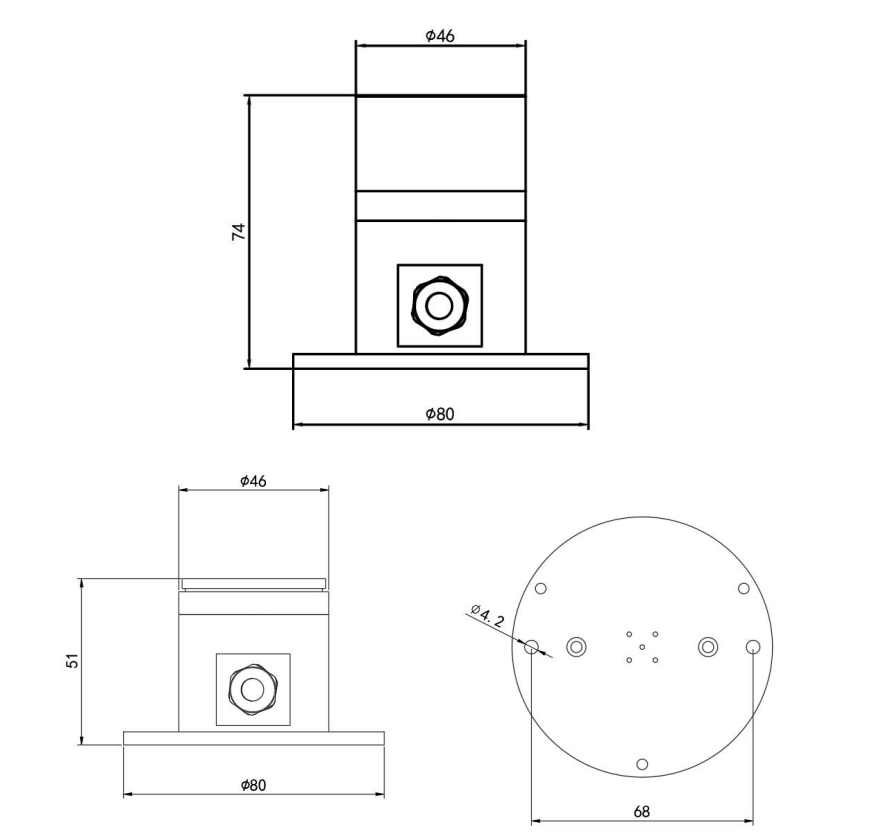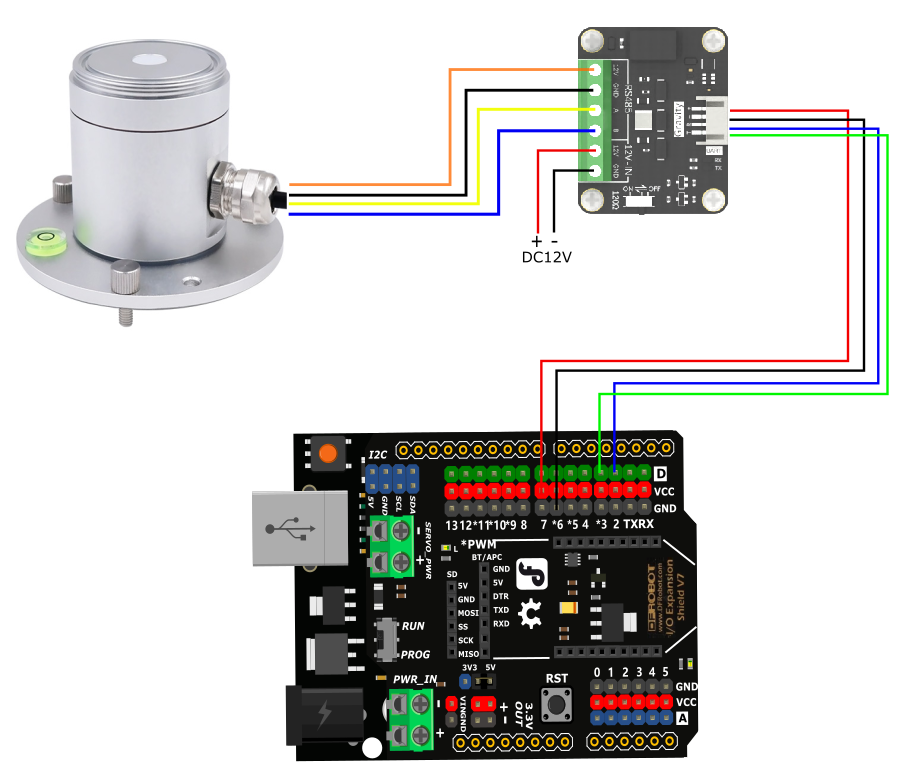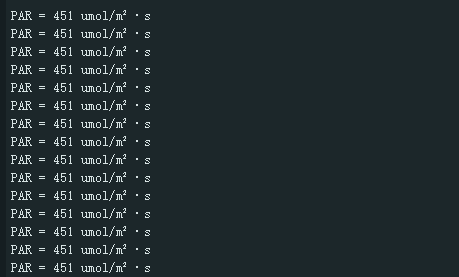Introduction
The photosynthetically active radiation sensor uses the principle of photoelectric sensing and can measure the photosynthetically active radiation value in the spectral range of 400-700nm. The sensor uses high-precision photoelectric sensing elements, wide spectrum absorption, high absorption, and good stability; when there is light, it generates a voltage signal proportional to the intensity of the incident radiation, and its sensitivity is proportional to the cosine of the direct angle of the incident light. The dust cover is specially treated to reduce dust adsorption and effectively prevent environmental factors from interfering with internal components, and can measure the photosynthetically active radiation value more accurately.
The photosynthetically active radiation sensor uses the standard Modbus-RTU 485 communication protocol and DC5-30V wide voltage power supply. It can be used with the TTL to RS485 expansion board (DFR0259) or Gravity: Active Isolated RS485 to UART Signal Adapter Module(DFR0845) to read the photosynthetically active radiation value on the Arduino UNO R3, quickly build a test environment, and the wiring method is simple and easy to use. The photosynthetically active radiation sensor has a protection level of IP67 and is made of metal aluminum shell. It is widely used in crop growth monitoring, photovoltaic systems, meteorological monitoring, plant physiology research, environmental protection and ecological research and other fields.
Explanation of measurement units:
umol/m²•s is the unit of photosynthetically active radiation. Photosynthetically active radiation refers to the radiation of effective light energy that plants can absorb and use during photosynthesis. Photosynthetically active radiation usually refers to light with a wavelength in the range of 400-700nm, which is the range of light required for plants to photosynthesize.
The umol in umol/m²•s stands for micromoles, a unit that describes the number of photons in the photosynthesis process. m² represents the area per square meter, and s represents the unit of time, i.e. seconds. Therefore, umol/m²•s represents the number of photons of photosynthetically active radiation per square meter per second.
The unit of photosynthetically active radiation, umol/m²•s, is often used to measure the intensity of photosynthesis and the growth status of plants. By measuring the number of photons of photosynthetically active radiation per square meter per second, the photosynthetic efficiency and photosynthetic rate of plant leaves can be evaluated, and a reference can be provided for plant growth, photosynthesis research, etc.
Features
- DC 5~30V wide voltage power supply
- Adopt high-precision photosensitive elements, high absorption in the full spectrum range
- Equipped with a level and adjustment handwheel, convenient for on-site adjustment
- Adopt RS485 interface, standard Modbus-RTU protocol
- Adopt high-quality cosine corrector to ensure standard cosine response
- Metal aluminum shell material, IP67 protection level
Applications
- Crop growth monitoring
- Photovoltaic system
- Weather monitoring
- Plant physiology research
- Environmental protection and ecological research
Specifications:
- Power supply voltage: DC5~30V
- Working current: <10mA
- Output mode: RS485
- Measurement range: 0~4000umol/m²•s
- Wavelength range: 400-700nm
- Accuracy: ±5% (1000umol/㎡•s, @550nm, 60%RH, 25℃)
- Resolution: 1 umol/m²•s
- Response time: 10us
- Non-linearity: <±1%
- Annual stability: ≤±2%
- Cosine response: ≤±10%
- Working temperature: -25°C~+60°C
- Protection level: IP67
- Sensor cable length: 20cm
- Adapter cable length: 70cm
Board Overview
| Num | Label | Description |
|---|---|---|
| Brown line | VCC | Power input positive pole, DC5-30V power supply |
| Black line | GND | Power ground wire |
| Yellow line | 485-A | RS485 data line A |
| Blue line | 485-B | RS485 data line B |
Dimensional Drawing

Communication Protocol
1. Basic communication parameters
| Interface | Encoding | Data bits | Parity bits | Stop bits | Error checking | Baud rate |
|---|---|---|---|---|---|---|
| RS485 | 8-bit binary | 8 | None | 1 | CRC | 2400bit/s, 4800bit/s, 9600 bit/s configurable, default 4800bit/s |
2. Data frame format definition
Using Modbus-RTU communication protocol, the format is as follows:
Initial structure ≥4 bytes of time
Address code = 1 byte
Function code = 1 byte
Data area = N bytes
Error check = 16-bit CRC code
End structure ≥4 bytes of time
Address code: The address of the sensor, which is unique in the communication network (factory default 0x01).
Function code: The function indication of the command sent by the host. This sensor reads the register function code 0x03 and writes the register function code 0x06
Data area: The data area is the specific communication data. Note that the high byte of 16-bit data is in front!
CRC code: A two-byte check code.
Host inquiry frame structure:
| Address code | Function code | Register start address | Register length | Check code low bit | Check code high bit |
|---|---|---|---|---|---|
| 1byte | 1byte | 2byte | 2byte | 1byte | 1byte |
Slave response frame structure:
| Address code | Function code | Number of valid bytes | Data area 1 | Data area 2 | Nth data area | Check code |
|---|---|---|---|---|---|---|
| 1byte | 1byte | 1byte | 2byte | 2byte | 2byte | 2byte |
Register address
| Register address | Content | Operation | Range and definition |
|---|---|---|---|
| 0000H | Photosynthetically active radiation value | Read-only | True value |
| 0052H | Deviation value | Read-write | Photosynthetically active radiation deviation value (16-bit signed) |
| 07D0H | Device address | Read-write | 1~254 (factory default 1) |
| 07D1H | Device baud rate | Read-write | 0 represents 2400, 1 represents 4800, 2 represents 9600 |
3. Communication protocol example and explanation
3.1、Read the current photosynthetically active radiation value
Inquiry frame: Read value function code 0x03
| Address code | Function code | Register start address | Register length | Check code low bit | Check code high bit |
|---|---|---|---|---|---|
| 0x01 | 0x03 | 0x00 0x00 | 0x00 0x01 | 0x84 | 0x0A |
Response frame:
| Address code | Function code | Return valid bytes | Solar radiation value | Check code low bit | Check code high bit |
|---|---|---|---|---|---|
| 0x01 | 0x03 | 0x02 | 0x00 0x64 | 0x9B | 0xAF |
Photosynthetically active radiation value:
0064 (hexadecimal) = 100=> Photosynthetically active radiation value = 100μmol/㎡·s
3.2, Write deviation value
Inquiry frame: Write value function code 0x06
| Address code | Function code | Register address | Modify value | Check code low position | Check code high position |
|---|---|---|---|---|---|
| 0x01 | 0x06 | 0x00 0x52 | 0x00 0x0A | 0xA8 | 0x1C |
Response frame:
| Address code | Function code | Register address | Modify value | Check code low position | Check code high position |
|---|---|---|---|---|---|
| 0x01 | 0x06 | 0x00 0x52 | 0x00 0x0A | 0xA8 | 0x1C |
Write the current photosynthetically active radiation deviation value
000A (hexadecimal) =10=> photosynthetically active radiation deviation value = 10μmol/㎡·s, deviation value is 10μmol/㎡·s
3.3 modify the current address
Inquiry frame: (modify the current address to 0x02)
| Address code | Function code | Register address | Modify value | Check code low position | Check code high position |
|---|---|---|---|---|---|
| 0x01 | 0x06 | 0x07 0xD0 | 0x00 0x02 | 0x08 | 0x86 |
Response frame:
| Address code | Function code | Register address | Modify value | Check code low position | Check code high position |
|---|---|---|---|---|---|
| 0x01 | 0x06 | 0x07 0xD0 | 0x00 0x02 | 0x08 | 0x86 |
3.4 Modify the current baud rate
Inquiry frame: (Modify the current baud rate to 9600)
| Address code | Function code | Register address | Modify value | Check code low bit | Check code high bit |
|---|---|---|---|---|---|
| 0x01 | 0x06 | 0x07 0xD1 | 0x00 0x02 | 0x59 | 0x46 |
Response frame:
| Address code | Function code | Register address | Modify value | Check code low bit | Check code high |
|---|---|---|---|---|---|
| 0x01 | 0x06 | 0x07 0xD1 | 0x00 0x02 | 0x59 | 0x46 |
3.5 Query current address and baud rate
Inquiry frame:
| Address code | Function code | Register address | Data length | Check code low | Check code high |
|---|---|---|---|---|---|
| 0xFF | 0x03 | 0x07 0xD0 | 0x00 0x02 | 0xD1 | 0x58 |
Response frame:
| Address code | Function code | Return valid bytes | Address | Baud rate | Checksum low bit | Checksum high bit |
|---|---|---|---|---|---|---|
| 0x01 | 0x03 | 0x04 | 0x00 0x01 | 0x00 0x01 | 0x6A | 0x33 |
The real address of the device read is 01, and the baud rate is 0x01, that is, 4800.
Tutorial
Requirements
-
Hardware
- DFRduino UNO R3 (or similar) x 1
- Gravity: Active Isolated RS485 to UART Signal Adapter Module x1
- RS485 Photosynthetically Active Radiation(PAR)Sensor x1
-
Software
Connection Diagram
If the power of the RS485 device is small and the required current is less than 12V-160mA, the RS485 to UART signal conversion module does not require a 12V external power supply, making wiring more convenient.

Sample Code
#include <SoftwareSerial.h>
SoftwareSerial mySerial(2,3);
uint8_t Com[8] = { 0x01, 0x03, 0x00, 0x00, 0x00, 0x01, 0x84, 0x0A };
int PAR;
void setup() {
Serial.begin(9600);
mySerial.begin(4800);
}
void loop() {
readPAR();
Serial.print("PAR = ");
Serial.print(PAR);
Serial.println(" umol/m²·s ");
delay(1000);
}
void readPAR(void) {
uint8_t Data[10] = { 0 };
uint8_t ch = 0;
bool flag = 1;
while (flag) {
delay(100);
mySerial.write(Com, 8);
delay(100);
if (readN(&ch, 1) == 1) {
if (ch == 0x01) {
Data[0] = ch;
if (readN(&ch, 1) == 1) {
if (ch == 0x03) {
Data[1] = ch;
if (readN(&ch, 1) == 1) {
if (ch == 0x02) {
Data[2] = ch;
if (readN(&Data[3], 4) == 4) {
if (CRC16_2(Data, 5) == (Data[5] * 256 + Data[6])) {
PAR = Data[3] * 256 + Data[4];
flag = 0;
}
}
}
}
}
}
}
}
mySerial.flush();
}
}
uint8_t readN(uint8_t *buf, size_t len) {
size_t offset = 0, left = len;
int16_t Tineout = 500;
uint8_t *buffer = buf;
long curr = millis();
while (left) {
if (mySerial.available()) {
buffer[offset] = mySerial.read();
offset++;
left--;
}
if (millis() - curr > Tineout) {
break;
}
}
return offset;
}
unsigned int CRC16_2(unsigned char *buf, int len) {
unsigned int crc = 0xFFFF;
for (int pos = 0; pos < len; pos++) {
crc ^= (unsigned int)buf[pos];
for (int i = 8; i != 0; i--) {
if ((crc & 0x0001) != 0) {
crc >>= 1;
crc ^= 0xA001;
} else {
crc >>= 1;
}
}
}
crc = ((crc & 0x00ff) << 8) | ((crc & 0xff00) >> 8);
return crc;
}
Expected Results
Print the collected photosynthetically active radiation value, which cannot be collected by ordinary indoor light sources.

FAQ
Possible reasons for no output or output errors:
- The sensor is a precision device. Please do not disassemble it by yourself when using it to avoid damage to the product.
- If the reading value is 0, check whether there is a light source and whether the product protective cover is removed.
- The 485 bus is disconnected, or the A and B lines are connected in reverse.
- Check whether the power supply meets the marking.
For any questions, advice or cool ideas to share, please visit the DFRobot Forum.